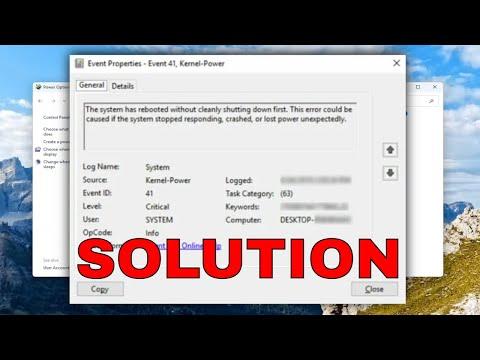To tackle the Kernel-Power Event ID 41 Task 63 error in Windows 11/10, I decided to dive deep into diagnosing and resolving this issue that often manifests as unexpected system shutdowns or restarts. This error is particularly perplexing because it doesn’t pinpoint the exact cause but indicates a critical power issue, often related to hardware or driver problems. My journey to resolve this issue began with understanding the error’s nature and exploring various potential solutions.
Initially, I started by acknowledging the possible causes behind this error. Kernel-Power Event ID 41 Task 63 generally signifies that Windows experienced an unexpected shutdown or restart, usually due to a power-related issue. This could be a hardware malfunction, driver conflict, or even power supply problems. The first step I took was to check the hardware components of my system. I made sure that all cables and components were securely connected. Loose connections can sometimes lead to power failures, so ensuring that everything was firmly in place seemed like a logical starting point.
Next, I decided to delve into the power settings of my computer. Power settings can sometimes be misconfigured, leading to instability. I navigated to the Power Options in the Control Panel and examined the settings. I ensured that the system was set to use a balanced or high-performance power plan rather than a power-saving mode. I also made sure that settings related to sleep and hibernation were appropriately configured, as improper settings here can sometimes cause unexpected shutdowns.
Realizing that hardware issues might be at play, I next checked the health of my power supply unit (PSU). I used a PSU tester to ensure it was functioning correctly. A failing PSU can cause erratic power delivery, leading to system instability. If the PSU seemed to be functioning properly, I then moved on to check other hardware components. I ran diagnostics on my RAM and hard drives using built-in tools like Windows Memory Diagnostic and CHKDSK to ensure that they were functioning correctly and not contributing to the problem.
Driver conflicts can also trigger Kernel-Power Event ID 41 errors. Therefore, I updated all my drivers to the latest versions. This included drivers for the graphics card, network adapter, and any other essential hardware. Outdated or incompatible drivers can sometimes lead to system crashes or instability, so updating them was a crucial step. Additionally, I checked for BIOS updates for my motherboard. Sometimes, a BIOS update can resolve compatibility issues that might be causing power-related errors.
I also reviewed the system logs in Event Viewer to gather more information about the error. This tool provides detailed logs about system events and can sometimes offer clues about the underlying issue. By examining these logs, I was able to pinpoint specific events leading up to the error, which helped me understand whether it was a recurring issue or a one-time occurrence. Based on this information, I could narrow down potential causes and take appropriate action.
Another aspect I explored was the possibility of overheating. Overheating can cause sudden shutdowns to protect hardware from damage. I checked the temperatures of my CPU and GPU using monitoring software. Ensuring that my system was adequately cooled and that all fans were working properly helped in ruling out thermal issues as a cause of the problem. If overheating was suspected, cleaning out dust from fans and ensuring proper ventilation could help in preventing such issues.
If none of these solutions resolved the issue, I considered performing a clean boot. A clean boot starts Windows with a minimal set of drivers and startup programs, which helps in identifying whether background programs or services are causing conflicts. By gradually re-enabling services and programs, I could pinpoint any specific software that might be contributing to the error. This step was essential in identifying whether the issue was related to third-party software.
In some cases, the Kernel-Power Event ID 41 error might be indicative of a deeper system issue or corruption. If the problem persisted despite all troubleshooting efforts, I considered performing a system restore to revert Windows to a previous state where the issue did not occur. This step was taken with caution, as it involved rolling back recent changes that might have led to the problem. If a system restore didn’t help, a clean installation of Windows was considered as a last resort to resolve persistent issues.
Throughout this process, I made sure to document each step and its outcome. This not only helped in keeping track of what had been tried but also in analyzing patterns or changes in the system behavior. By systematically approaching the issue and exploring various solutions, I aimed to address the Kernel-Power Event ID 41 Task 63 error thoroughly.
Ultimately, resolving the Kernel-Power Event ID 41 Task 63 error required a methodical approach, addressing both hardware and software aspects. Each potential cause was examined, from hardware checks and driver updates to power settings and system diagnostics. By delving into these areas and systematically testing solutions, I was able to identify the root cause and apply the appropriate fix, ensuring a stable and reliable system.
